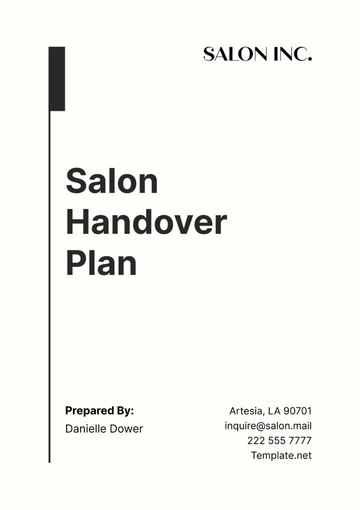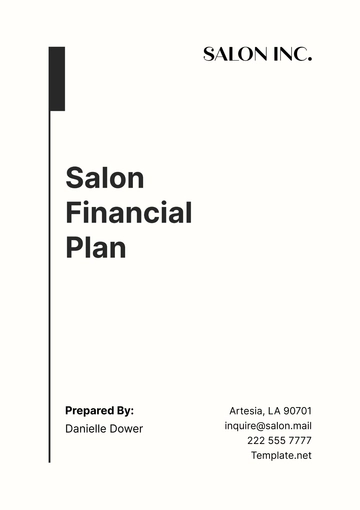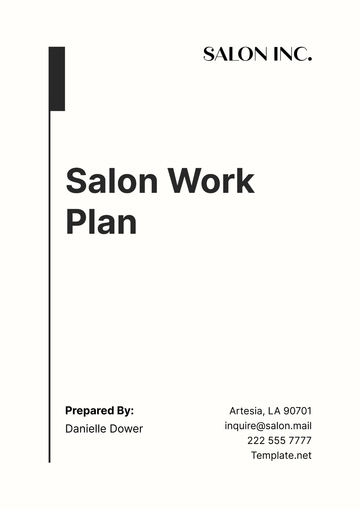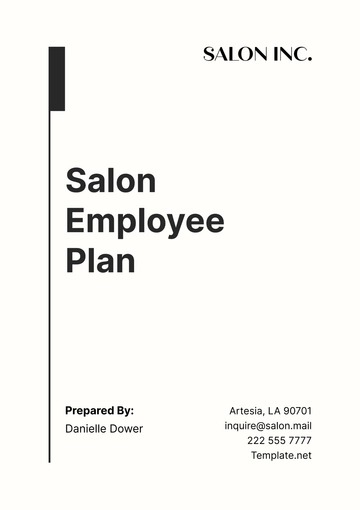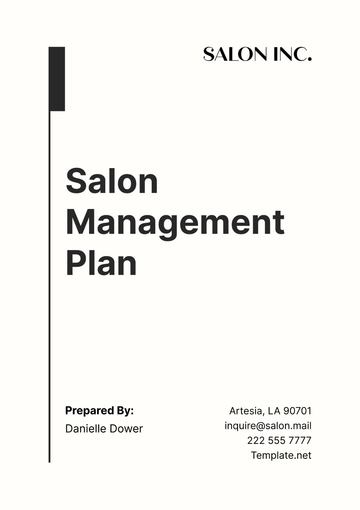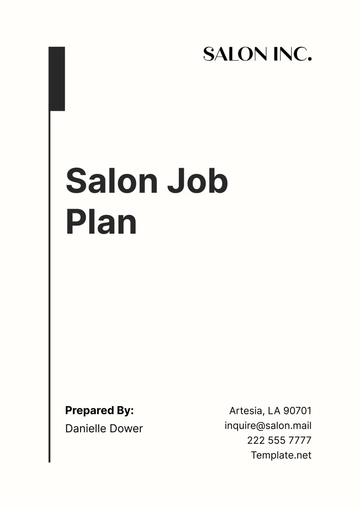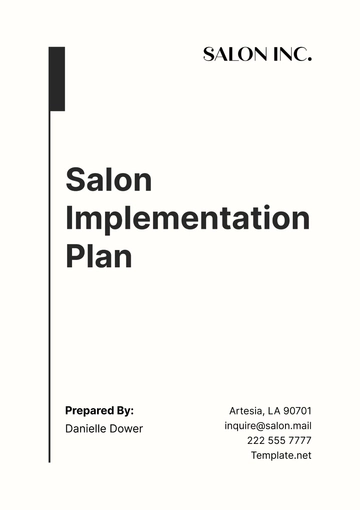Free Salon Financial Plan
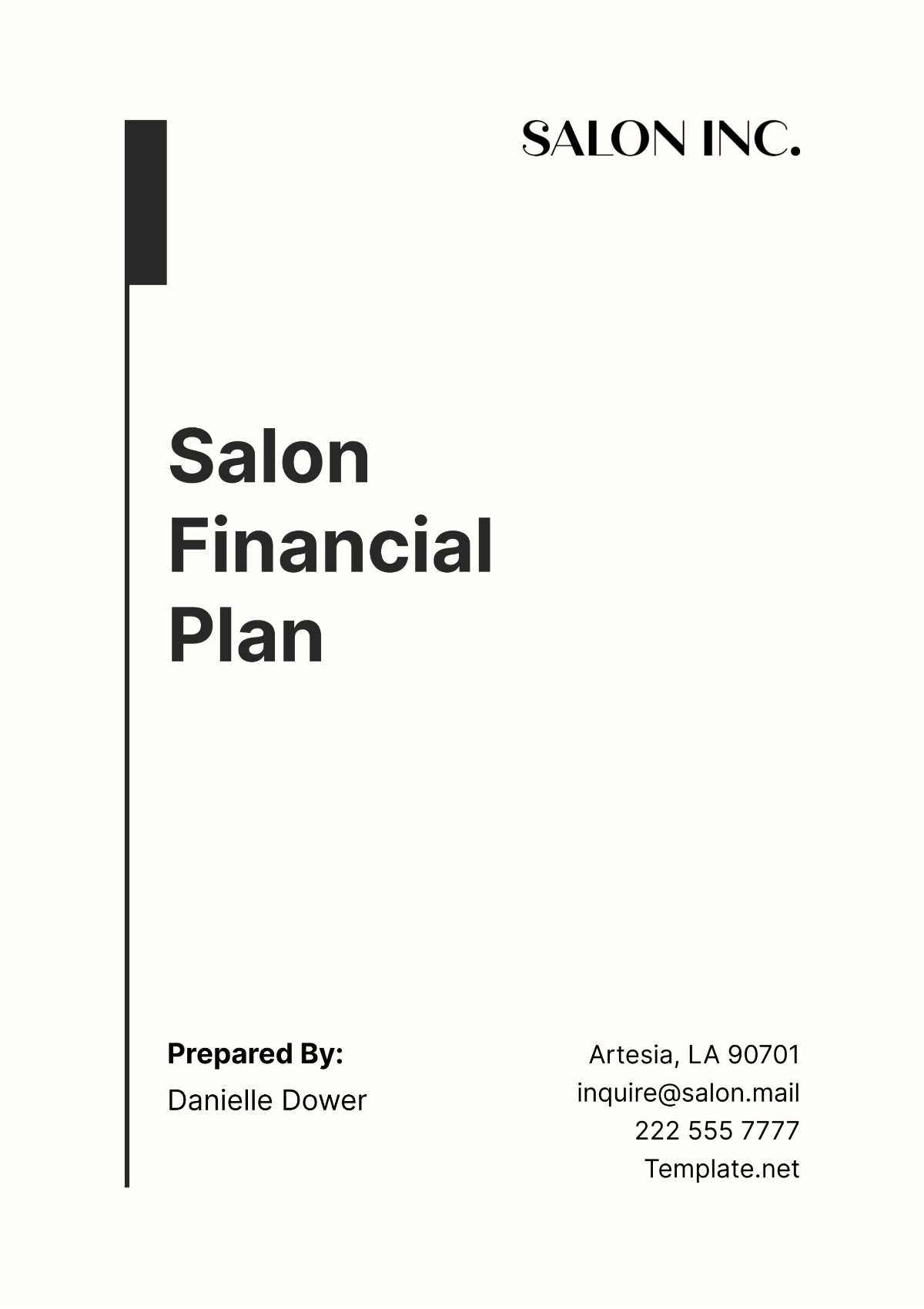
A. Executive Summary
The Salon Financial Plan by [Your Company Name] serves as a robust financial roadmap meticulously crafted for salon proprietors in the United States. This comprehensive tool is engineered to offer a detailed financial framework, integrating budgeting, forecasting, and strategic financial analysis. Its primary objective is to optimize profitability and foster sustainable growth within the salon industry. By focusing on actionable insights and strategic financial decisions, this template ensures alignment with the business's overarching goals and prevailing market conditions.
Salon owners can leverage this template to navigate complex financial landscapes with confidence, making informed decisions that drive long-term success. With a keen emphasis on financial prudence and strategic foresight, this plan equips salon businesses to thrive amidst evolving economic dynamics and competitive pressures.
B. Objectives
The objectives outlined in this Salon Financial Plan Template serve as guiding principles to drive financial success and operational excellence within the salon industry. By prioritizing these objectives, salon owners can establish a solid foundation for sustainable growth and profitability, while ensuring compliance with regulatory standards.
Establish Realistic Financial Goals: Utilizing detailed market analysis, set achievable financial targets that align with the salon's growth trajectory and market potential.
Enhance Profitability: Implement strategies focused on effective cost management and revenue optimization to maximize the salon's profitability and financial performance.
Develop Robust Cash Flow Management: Establish a comprehensive cash flow management system to maintain operational stability and ensure timely payment of expenses, thereby safeguarding against liquidity challenges.
C. Revenue Streams
In pursuit of financial stability and diversification, the salon will capitalize on multiple revenue streams to bolster its financial position. By offering a range of services and products, the salon aims to attract a diverse clientele while maximizing revenue potential. The sources include:
Hair cutting, styling, and coloring services.
Beauty treatments, including facials and skincare services.
Selling hair and beauty products.
Membership or subscription models for regular customers.
Seasonal promotions and special event services.
D. Cost Structure
Efficient cost management is paramount to ensuring the profitability and sustainability of the salon business. This section outlines the key categories of expenses that the salon will incur in its operations. By diligently monitoring and optimizing these costs, the salon can maintain financial stability while delivering exceptional services to its clientele.
Expense Category | Expense Details |
|---|---|
Rent or Lease Payments | Monthly payments for the rental or leasing of the salon space. |
Salon Equipment and Supplies | Costs associated with purchasing and replenishing salon equipment and supplies. |
Employee Salaries | Wages and benefits for salon staff, including training and development expenses. |
Marketing and Advertising | Expenses related to promoting the salon's services and attracting new customers. |
Utility Costs | Regular utility expenses such as electricity, water, and internet services. |
E. Budget Planning
Effective budget planning is essential for the prudent management of financial resources within the salon business. This section delineates the annual budget, offering a comprehensive framework to allocate funds strategically and ensure financial stability. By incorporating projected revenues, cost breakdowns, and provisions for contingencies, the salon aims to optimize resource utilization and support its growth objectives.
Budget Component | Amount ($) |
|---|---|
Projected Revenues | [0] |
Fixed Costs | [0] |
Variable Costs | [0] |
Total Costs | [0] |
Allocation of Funds | |
| [0] |
| [0] |
| [0] |
Emergency Reserves | [0] |
Budget Reviews | [0] |
F. Financial Forecasting
Accurate financial forecasting is pivotal for anticipating future income, expenses, and overall profitability within the salon business. This section focuses on projecting financial outcomes based on historical data, market trends, and strategic initiatives, empowering salon owners to make informed decisions and plan for future growth.
The provided dataset offers monthly projections for revenue, expenses, and profit. These estimates are derived from historical data, market analysis, and business projections. For instance, in January, revenue is projected at $10,000, with expenses expected to total $8,000, resulting in a profit of $2,000. Similar trends continue throughout the months, allowing salon owners to anticipate cash flow patterns and make informed decisions to optimize profitability and ensure financial stability.
G. Risk Management
Identifying and mitigating financial risks is paramount for maintaining the long-term health and stability of the salon business. The following strategies are integral components of the risk management plan:
1. Regular Financial Audits: Conducting periodic financial audits ensures accuracy in financial reporting and compliance with regulatory requirements. By reviewing financial records and internal controls, potential discrepancies and areas of improvement can be identified and addressed promptly.
2. Debt Management Strategies: Implementing effective debt management practices helps reduce financial leverage and minimize the risk of default. This may involve developing a structured repayment plan, negotiating favorable terms with creditors, and exploring options for refinancing or debt consolidation.
3. Revenue Stream Diversification: Diversifying revenue streams helps mitigate the impact of economic downturns or fluctuations in specific market segments. By offering a variety of services and products, the salon can spread risk across multiple income sources, reducing reliance on any single revenue stream.
4. Insurance Planning: Adequate insurance coverage is essential for protecting salon assets, employees, and operations from unforeseen events such as property damage, liability claims, or business interruptions. This may include property insurance, liability coverage, workers' compensation, and business interruption insurance.
5. Establishing Strong Financial Relationships: Building strong relationships with financial institutions, such as banks or credit unions, can provide access to valuable resources and financial support when needed. This includes maintaining open communication, demonstrating financial responsibility, and seeking guidance on risk management strategies tailored to the salon's specific needs.
H. Capital Investment Strategies
Funding future growth requires careful planning and execution of capital investments. Strategies include:
Reinvestment of profits for sustainable growth.
Securing loans at competitive interest rates for expansion.
Exploring venture capital opportunities for large scale projects.
Engaging in lease versus buy analysis for new equipment.
Investing in technology to improve service delivery and efficiency.
I. Performance Metrics
Monitoring performance metrics is essential for evaluating the financial health and success of the salon business. The following key performance indicators (KPIs) will be tracked to gauge performance and inform strategic decision-making:
1. Revenue Growth Year-Over-Year: Tracking revenue growth on an annual basis provides insights into the salon's ability to generate increasing income over time. By comparing current revenue to previous years, trends can be identified, and growth strategies can be refined accordingly.
2. Gross Margin and Net Profit Margins: Analyzing gross and net profit margins helps assess the efficiency of operations and profitability. A healthy gross margin indicates effective cost management, while a strong net profit margin reflects the salon's ability to generate profits after all expenses are accounted for.
3. Client Retention Rates: Client retention rates measure the percentage of customers who continue to patronize the salon over time. High retention rates indicate satisfied customers and a loyal client base, which contributes to long-term revenue stability and growth.
4. Cost per Acquisition of New Clients: Calculating the cost per acquisition of new clients helps evaluate the effectiveness of marketing and advertising efforts. By comparing the cost of acquiring new customers to their lifetime value, the salon can determine the return on investment for various marketing initiatives.
5. Return on Investment for Marketing Initiatives: Assessing the return on investment (ROI) for marketing initiatives quantifies the effectiveness of marketing campaigns and strategies. By analyzing the revenue generated from marketing efforts relative to the costs incurred, the salon can optimize its marketing budget and focus on strategies that yield the highest ROI.
J. Reporting and Compliance
The salon will adhere to all financial reporting requirements and ensure full compliance with tax laws. This includes:
Monthly financial statements, including income statement, balance sheet, and cash flow statements.
Quarterly tax filings and annual returns.
Adherence to local, state, and federal tax laws.
Implementing financial controls to prevent fraud and errors.
Regular compliance audits and adjustments based on legal changes.
K. Conclusion
In conclusion, the Salon Financial Plan Template provided by [Your Company Name] offers a robust framework to navigate the financial landscape of a salon business. By following this comprehensive plan, salon owners can streamline their financial strategy and operations, leading to improved performance and sustained growth. With a focus on strategic financial management, including revenue diversification, cost control, and risk mitigation, salons can optimize their financial health and capitalize on opportunities within this dynamic industry.
Embracing the principles outlined in this template empowers salon owners to make informed decisions, adapt to market changes, and ultimately unlock the full potential of their business. Through diligent implementation of the strategies outlined herein, salons can thrive amidst evolving economic conditions and emerge as leaders in the beauty and wellness sector.
- 100% Customizable, free editor
- Access 1 Million+ Templates, photo’s & graphics
- Download or share as a template
- Click and replace photos, graphics, text, backgrounds
- Resize, crop, AI write & more
- Access advanced editor
Develop comprehensive financial plans with ease using the Salon Financial Plan Template from Template.net. This editable and customizable document simplifies the creation of financial strategies for your salon business. Tailored for the beauty industry, it ensures professionalism in outlining budget allocations, revenue forecasts, and expense management. Editable in our Ai Editor Tool for seamless customization, ensuring financial stability and growth for your salon has never been simpler.
You may also like
- Finance Plan
- Construction Plan
- Sales Plan
- Development Plan
- Career Plan
- Budget Plan
- HR Plan
- Education Plan
- Transition Plan
- Work Plan
- Training Plan
- Communication Plan
- Operation Plan
- Health And Safety Plan
- Strategy Plan
- Professional Development Plan
- Advertising Plan
- Risk Management Plan
- Restaurant Plan
- School Plan
- Nursing Home Patient Care Plan
- Nursing Care Plan
- Plan Event
- Startup Plan
- Social Media Plan
- Staffing Plan
- Annual Plan
- Content Plan
- Payment Plan
- Implementation Plan
- Hotel Plan
- Workout Plan
- Accounting Plan
- Campaign Plan
- Essay Plan
- 30 60 90 Day Plan
- Research Plan
- Recruitment Plan
- 90 Day Plan
- Quarterly Plan
- Emergency Plan
- 5 Year Plan
- Gym Plan
- Personal Plan
- IT and Software Plan
- Treatment Plan
- Real Estate Plan
- Law Firm Plan
- Healthcare Plan
- Improvement Plan
- Media Plan
- 5 Year Business Plan
- Learning Plan
- Marketing Campaign Plan
- Travel Agency Plan
- Cleaning Services Plan
- Interior Design Plan
- Performance Plan
- PR Plan
- Birth Plan
- Life Plan
- SEO Plan
- Disaster Recovery Plan
- Continuity Plan
- Launch Plan
- Legal Plan
- Behavior Plan
- Performance Improvement Plan
- Salon Plan
- Security Plan
- Security Management Plan
- Employee Development Plan
- Quality Plan
- Service Improvement Plan
- Growth Plan
- Incident Response Plan
- Basketball Plan
- Emergency Action Plan
- Product Launch Plan
- Spa Plan
- Employee Training Plan
- Data Analysis Plan
- Employee Action Plan
- Territory Plan
- Audit Plan
- Classroom Plan
- Activity Plan
- Parenting Plan
- Care Plan
- Project Execution Plan
- Exercise Plan
- Internship Plan
- Software Development Plan
- Continuous Improvement Plan
- Leave Plan
- 90 Day Sales Plan
- Advertising Agency Plan
- Employee Transition Plan
- Smart Action Plan
- Workplace Safety Plan
- Behavior Change Plan
- Contingency Plan
- Continuity of Operations Plan
- Health Plan
- Quality Control Plan
- Self Plan
- Sports Development Plan
- Change Management Plan
- Ecommerce Plan
- Personal Financial Plan
- Process Improvement Plan
- 30-60-90 Day Sales Plan
- Crisis Management Plan
- Engagement Plan
- Execution Plan
- Pandemic Plan
- Quality Assurance Plan
- Service Continuity Plan
- Agile Project Plan
- Fundraising Plan
- Job Transition Plan
- Asset Maintenance Plan
- Maintenance Plan
- Software Test Plan
- Staff Training and Development Plan
- 3 Year Plan
- Brand Activation Plan
- Release Plan
- Resource Plan
- Risk Mitigation Plan
- Teacher Plan
- 30 60 90 Day Plan for New Manager
- Food Safety Plan
- Food Truck Plan
- Hiring Plan
- Quality Management Plan
- Wellness Plan
- Behavior Intervention Plan
- Bonus Plan
- Investment Plan
- Maternity Leave Plan
- Pandemic Response Plan
- Succession Planning
- Coaching Plan
- Configuration Management Plan
- Remote Work Plan
- Self Care Plan
- Teaching Plan
- 100-Day Plan
- HACCP Plan
- Student Plan
- Sustainability Plan
- 30 60 90 Day Plan for Interview
- Access Plan
- Site Specific Safety Plan











